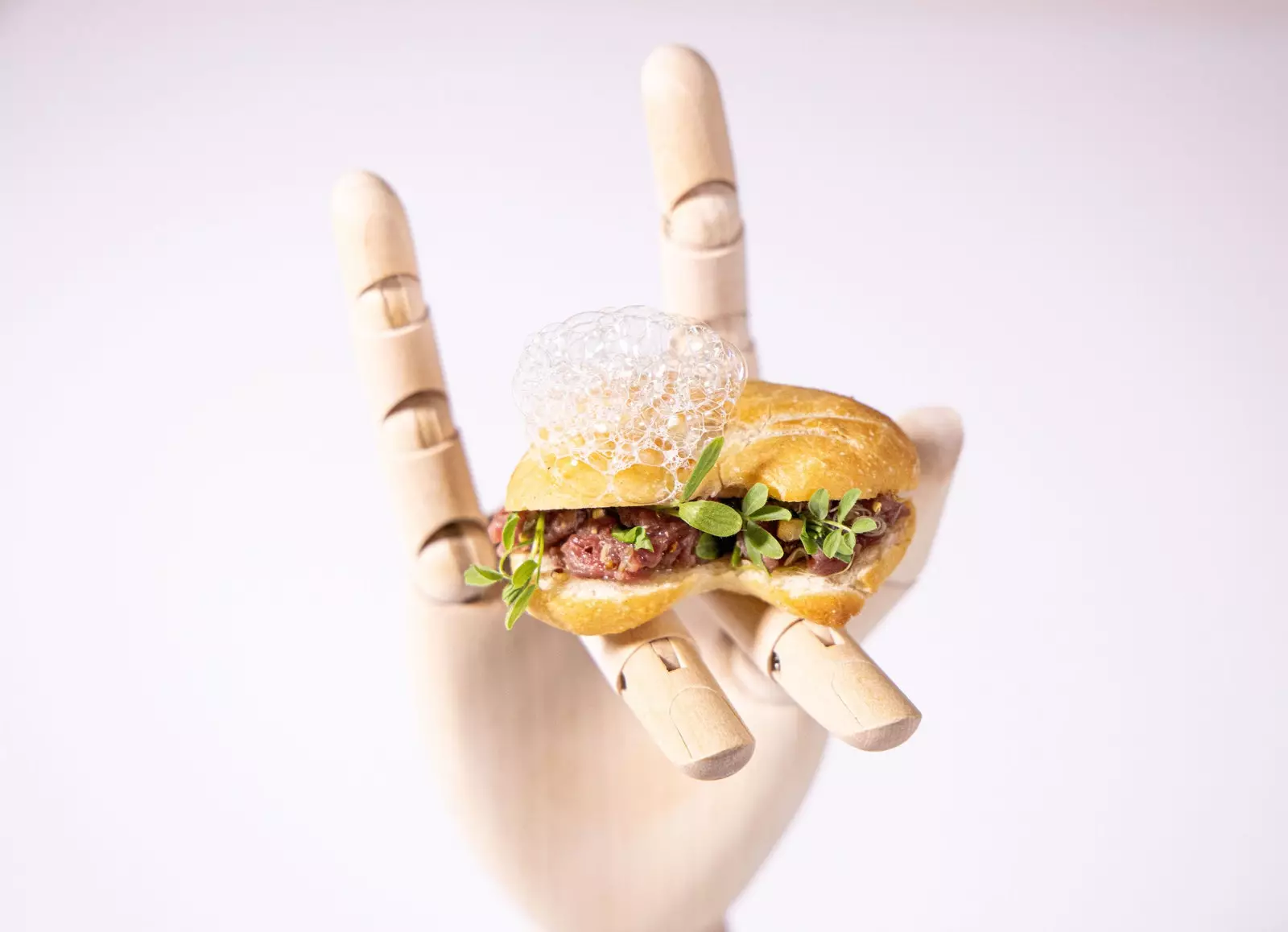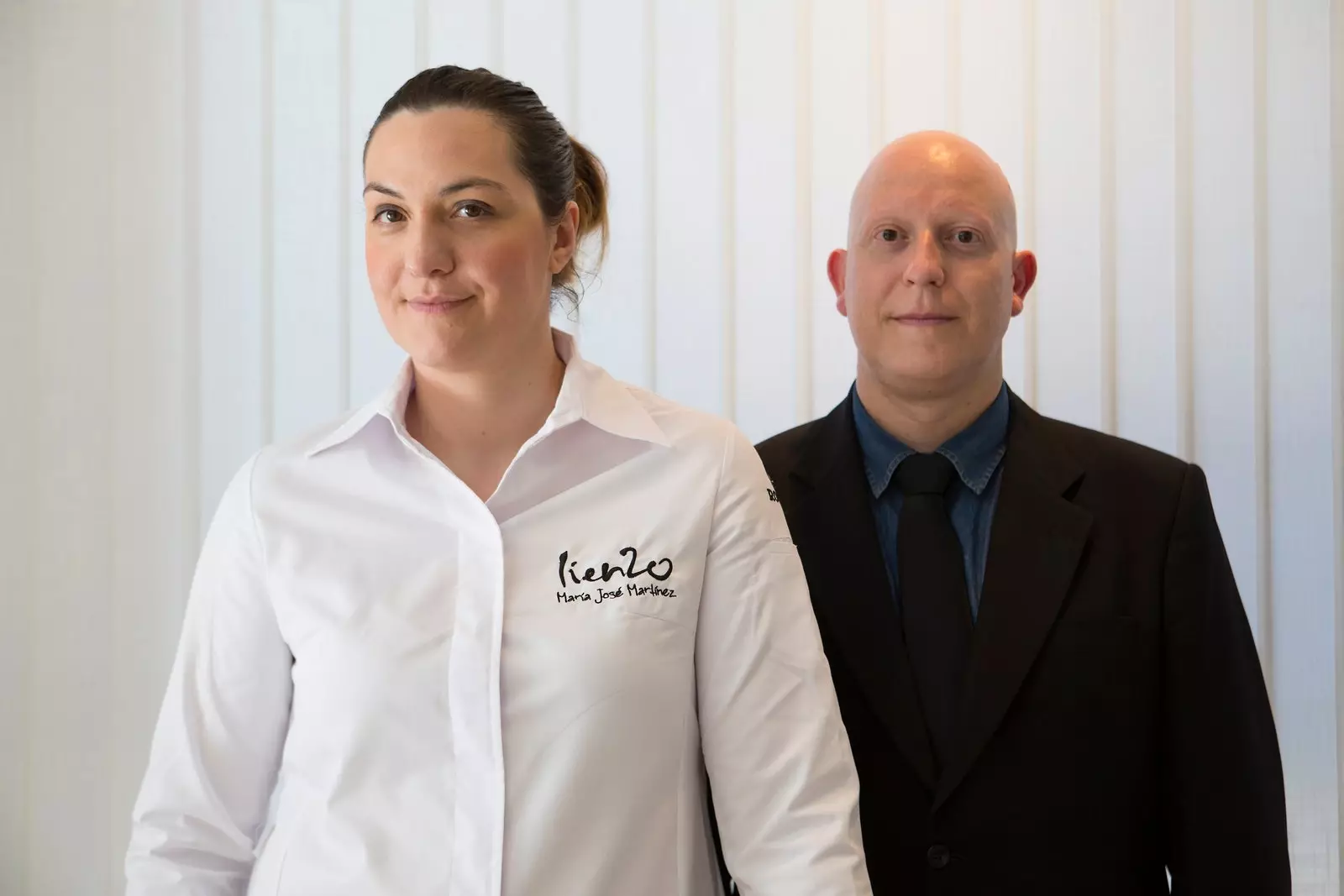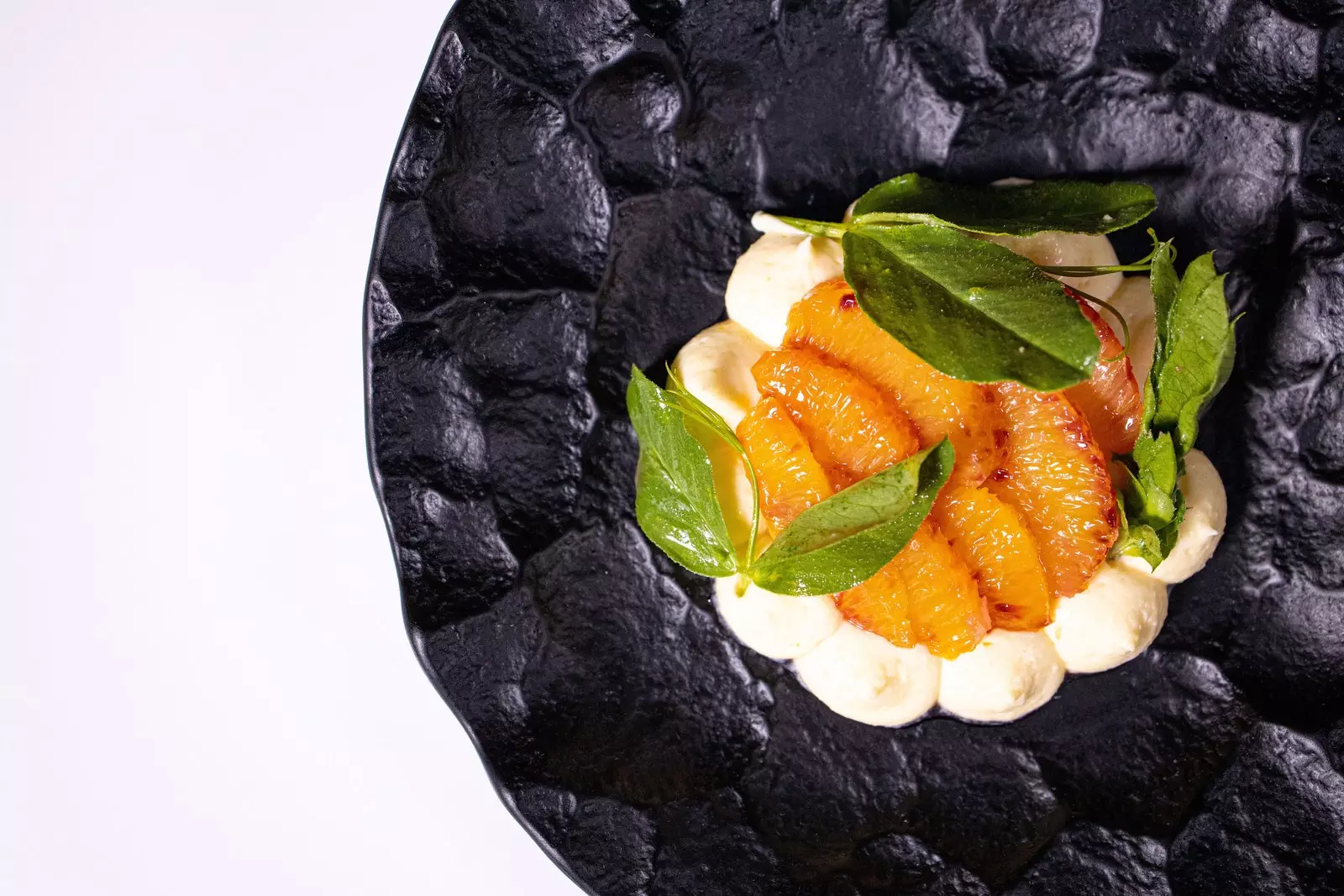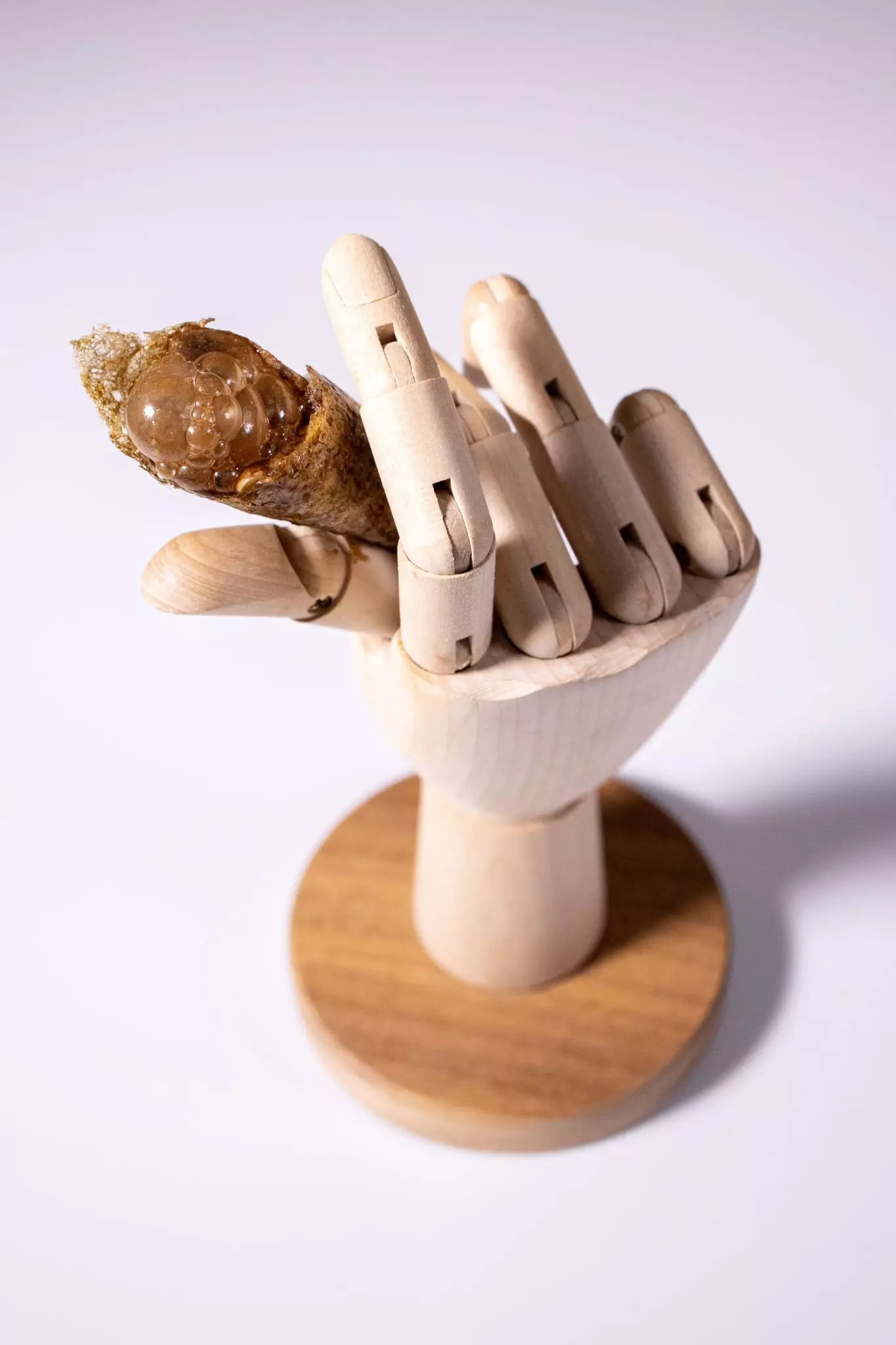
Mini pataqueta stuffed with foal tartare with pepper air in Valencian brine, from the restaurant Canvas Print
What they don't get the orchard, the sea or the Valencian mountain , through local producers or even with their own hives, they imagine it and invent it: that is the modus operandi of Maria Jose Martinez , head chef, and Juanjo Soria, the “metrelier”, as he likes to be called (de Maître + Sommelier). Mead or codium mustard (a seaweed) are some of the great successes of this Murcian chef, although others fall by the wayside. But that limitless creativity it is surprising and magical: every day something occurs to him, he cannot stop. The invention of that spring day was an edible centerpiece, made with green tulip flowers and almond . The last one (which has come to stay), its zero kilometer craft beer with raw urban honey from the Valencia Botanical Garden , which is a mix of Blonde and Pale Ale, made by Valentivm in collaboration with beekeeper Diego Bour.
It is noted that honey is the fetish product of María José , whose paternal family she has 12 hives in her town, Alhama de Murcia, in Sierra Espuña . “It was already used in Egypt in the year 3,500 BC to heal wounds. It was also the first drink in history, long before wine or beer." And that is why she is recovering stories about this liquid gold to count them through their tasting menus : He has been researching with it for months and has already used it in snacks like the textured beet cone , that she carried chestnut honey, in dishes like her Aged monkfish with miso and honey or in desserts like Honey, yuzu and its fermented products, with four types of honey: lavender, rosemary, orange blossom and chestnut.
But her commitment goes much further: in all her desserts she has substituted 80% of the sugar for this sweet elixir . “Whipped yolks or meringue go very well with honey, instead of sugar. But I can't change the fondant to crystallize yet." Although he did not give up. Nothing is put forward for this Murcian woman: for a reason she is one of the promoters of the Association of Women in Gastronomy, which emerged in 2018 from a meeting of female cook friends at the Monastrell restaurant (Alicante) in María José San Román, current president , and what about make visible the female role in this sector , sometimes so muted. She is a good example: she got third place as Revelation Chef at Madrid Fusion 2016 , she has a Sol Repsol and the recognition of Michelin Plate from the French guide and she is on our list of most influential women in the gastronomic world.

María José and Juanjo, from Canvas
Perhaps the secret is her tenacity... and that she never tires of testing: her fridge looks like a laboratory . Turns out she studied Chemistry. the last thing is osmotized onion in honey . She "she does many things but they last very little". Juanjo tells us, who has been by her side for 15 years and, for the last 10, as his partner on a personal and professional level. It doesn't sound reproachful: when he whispers it to us, his eyes shine and we perceive that admiration of someone who accompanies and inspires a genius. He is mutual.
He (also) is in love with wine: he defends in the living room, just like María José in the kitchen, what is close . “I don't know how to sell international wines… and I don't have a market either. I am personally passionate about French red and German white, but of the 260 references we have, almost all are national. I also look for our diner to leave his comfort zone: in two of our menus, which may or may not touch you, there are neither Riberas nor Riojas . And it's not a mistake: I want you to try other things”.
Here everything is different (and changing) . Even the packaging: before being a restaurant it was a gallery and now the walls of Canvas They are also dotted with works of art by Valencian artists , which change every 3 months. On canvas, the words conformism or immobility do not exist : where all this gastronomic magic happens now, years ago steaks, patatas bravas or Russian salads were served. When María José and Juanjo took the reins, they opted for the gastrotapas (from roast beef patties to mini squid burgers) but they soon realized that customers wanted something else: to chart their own path.
They have been doing this for five years: “we focus a lot on the product, valuing what is close to us”. That is why they are firm defenders of proximity: everything that enters the kitchen of Lienzo, everything that reaches the plate, it is ecological and zero kilometer . “I am not interested in meats that are not from here.” And she proves it with her Foal tartare pataqueta, green pepper and pickled pepper air, a tribute to the Valencian esmorzaret (paired, of course, with a Turia beer). But also with its plate of artichokes, strawberries with fermented pepper and lamb lleterolas (gizzards). The foal is from Valencia and the sweetbreads and the lamb, from Viver (Castellón).

Sandina orange, fondillon and crazy bean, from Canvas Print
Everything else is also ode to the Valencian pantry : the artichokes are from Benisano and the strawberries Channels . His green asparagus, which he cooks in a very peculiar papillote (“There is nothing more primitive than clay. Why use plastic?”) Are from Castellon just like the rabbit. And the oysters, which are served with a game marinade, are from port of Valencia . Although it is the totena squid, very typical of the area, that has served to build what is already his most iconic dish, the one that marked a before and after: Squid, dashi and tuille has been on the menu for several years. Between courses, we ask him about the bread: he buys it from Jesús Machi (The Furnace of San Bartolomé ), Valencian baker who has more and more followers.
María José also uses her creations as a vindication: her Lamb, carob and mint is used so that diners appreciate this fruit, sometimes reviled because it has traditionally been used as cattle feed but little by little is gaining weight in the gastronomy of the area . You will also eat it in its addictive Crunchy cone of coffee, carob and topinambo toffee . The Murcian chef exhibits such a Mediterranean color palette that she does not need to leave the Valencian Community to paint her pictures. But there is one exception: extra virgin olive oil, from picual olives and from centuries-old olive trees, is produced and bottled Egoleum in Benalúa de las Villas (Grenade).
Several hours later, we leave Canvas Print savoring their honey and with the old but sweet flavor of the fondillón still in the mouth, thinking that more passionate people like them are needed, who dare to repaint canvases, who live in that eternal honeymoon. María José and Juanjo have learned to turn failures into art and to make everything happen: if it doesn't exist, create it. The love for cooking (and for life) was this.

Crunchy cone of coffee, carob and topinambo toffee, from Canvas Print
*** Canvas reopens its doors this Friday June 12th. Its capacity is 100 people, but they have always worked at 50% and their ten tables were already, originally, distanced. ***
Address: Plaça de Tetuán 18, lower right. Valencia. See map
Telephone: 963521081
Half price: Trazos Menu: 7 passes, €35. Available every day except Friday and Saturday night. Brushstrokes: 10 passes, €50. Canvas: 15 passes, €65. All include bread and oil service. They also have a menu of about 20 dishes.
